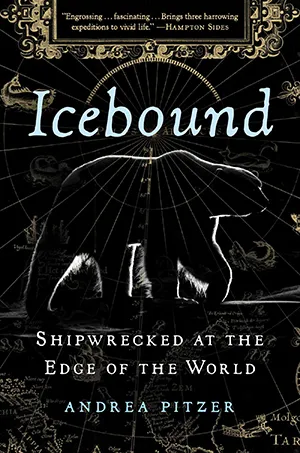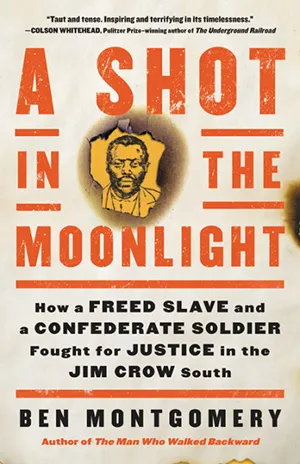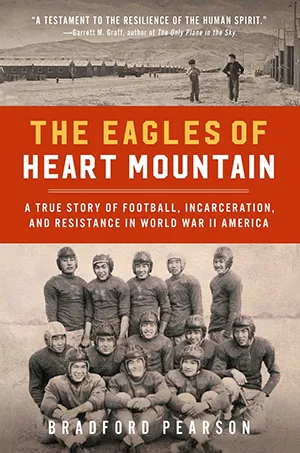A Doomed Arctic Expedition, Number-Free Math and Other New Books to Read
These five January releases may have been lost in the news cycle
/https://tf-cmsv2-smithsonianmag-media.s3.amazonaws.com/filer/e8/5b/e85b5b98-d697-4df5-97c1-4d6f7792a876/booksweek14.png)
Seven days into his long-awaited journey home, 16th-century Dutch explorer William Barents, who’d been stranded in the Arctic for almost a year after unsuccessfully seeking out a northeastern passage to China, succumbed to scurvy and the ill effects of eating toxic polar bear liver. A seasoned cartographer and navigator, he’d dedicated the last years of his life to the search, embarking on three expeditions fated to end in failure.
Barents’ demise, writes journalist Andrea Pitzer in Icebound: Shipwrecked at the Edge of the World, secured his status as “the patron saint of devoted error, [launching] the pattern of the famous Arctic explorer who endured horrifying privations for a noble cause.” But more than 400 years after his death, the man who later lent his name to the Barents Sea remains little known, his efforts overshadowed by the exploits of such explorers as Ernest Shackleton and John Franklin.
The latest installment in our series highlighting new book releases, which launched last March to support authors whose works have been overshadowed amid the Covid-19 pandemic, details the explorer’s forgotten Arctic travails, a formerly enslaved man’s fight for justice in the Jim Crow South, the triumphs of a World War II incarceration camp’s Japanese American football team, math without numbers and the legacy of Alice Walker’s The Color Purple.
Representing the fields of history, science, arts and culture, innovation, and travel, selections represent texts that piqued our curiosity with their new approaches to oft-discussed topics, elevation of overlooked stories and artful prose. We’ve linked to Amazon for your convenience, but be sure to check with your local bookstore to see if it supports social distancing–appropriate delivery or pickup measures, too.
Icebound: Shipwrecked at the Edge of the World by Andrea Pitzer

In Icebound, Pitzer—who previously penned a global history of concentration camps and a biography of the enigmatic Russian novelist Vladimir Nabokov—continues the trend of unearthing “events and ideas that were once common knowledge but have fallen from public memory,” as she writes on her website. Drawing on historical sources like a diary kept by Gerrit de Veer, who was one of 12 men to return from the 1596–97 expedition, as well as firsthand accounts of her own attempts to retrace the explorer’s steps, the journalist conveys the sheer terror experienced by the stranded sailors, who spent ten months staving off hypothermia in subzero temperatures and battling polar bear attacks while awaiting winter’s end. (Pitzer will discuss her research with wildlife biologist and author Jonathan C. Slaght during a virtual Smithsonian Associates event on March 11. Tickets are available here.)
Barents first sailed to the Arctic in 1594. Eager to find a northern naval route to Asia, he reached the northern Russian archipelago of Nova Zembla but was forced to turn around after encountering icebergs. (The explorer subscribed to the now-debunked theory of an ice-free ocean surrounding the North Pole, an “easily navigable sea … that might carry [merchants] over the top of the world and deliver them to profitable lands,” according to Pitzer.) Dutch investors buoyed by the relative success of this initial venture—no one died, and the party identified two seemingly promising paths, per Kirkus—financed a second expedition the next year. This time around, Barents lost men to mutiny, bear attacks and drownings alike; by late 1595, he was the only one willing to continue the voyage.
The explorer’s third and final expedition—a more muted affair than its predecessors—departed the Netherlands in May 1596. That August, Barents and his crew of 16 found their ship trapped in the ice off of Nova Zembla’s northeastern tip. Unable to free the vessel, they consigned themselves to a winter of “great cold, poverty, misery, and griefe,” as de Veer lamented in his journal. Over the following months, the men endured bitter cold that all but trapped them in their makeshift shelter. Sanitary conditions deteriorated quickly, and snow “threatened to bury the crew alive,” writes Michael O’Donnell in a review for the Wall Street Journal. “... Time lost all meaning in the dark of winter as starvation and scurvy ravaged the men’s bodies.” Multiple crew members died.
In June 1597, the surviving sailors—hoping to take advantage of the milder spring climate—abandoned their ice-encased ship and set sail in two smaller boats. Barents died seven days into the journey. He’d “failed to deliver on his ... mission in nearly every way,” notes Pitzer in an excerpt adapted for the New York Review of Books, but enjoyed a posthumous boost in reputation thanks to best-selling accounts of his travels. During the 19th century, when rising Dutch nationalism and a resurgence of interest in exploring the uncharted Arctic fostered a culture of celebrity, Barents once again entered the spotlight.
“It is no wonder that Barents’s own reputation grew during this era,” adds Pitzer. “[H]is ordeal could easily be bent to fit this new view of Arctic exploration as man’s heroic struggle against nature and his danger-filled efforts to dominate it.”
A Shot in the Moonlight: How a Freed Slave and a Confederate Soldier Fought for Justice in the Jim Crow South by Ben Montgomery

On the night of January 21, 1897, a mob of white vigilantes arrived at George Dinning’s Kentucky home and falsely accused him of theft. When the formerly enslaved farmer, who had lived in the area for the past 14 years, tried to reason with the men, they opened fire, hitting his arm and threatening the safety of his wife and children, who were huddled inside, according to research conducted by journalist Roland Klose. He shot back, killing the son of a wealthy white farmer, and in the ensuing chaos, sustained another injury to the head. The following morning, Dinning turned himself in to the local sheriff, who promptly transferred his new prisoner to a different city to avoid a jailhouse riot and likely lynching. That same week, the mob returned to Dinning’s Simpson County farm, setting the property ablaze and forcing his family to flee.
Despite the fact that he had clearly acted in self-defense, an all-white jury convicted Dinning of manslaughter and sentenced him to seven years in prison. Less than two weeks later, Kentucky Governor William O’Connell Bradley, an ardent supporter of black rights, pardoned Dinning, declaring, “In protecting himself he did no more than any other man would or should have done under the same circumstances.”
A Shot in the Moonlight, by Pulitzer Prize–nominated journalist Ben Montgomery, recounts the surprising events that happened next. Determined to seek justice, Dinning recruited lawyer Bennett H. Young, a Confederate war hero who had dedicated his post-war years to aiding the formerly enslaved, to represent him in a civil case against his attackers. Young won, securing his client damages of $50,000, or roughly $1.4 million today, reports Klose. Because the defendants claimed to be impoverished, Dinning received just a small portion of this settlement—$1,750—but the precedent set by his case remained significant: As a New Orleans newspaper reported at the time, according to Klose, “The outcome is regarded as sensational, indicating an entirely new method of dealing with and punishing lawless mobs that have been so numerous in the south.”
Young was a man of contradictions, says Montgomery, disavowing “slavery and injustice, while still trying to honor the memories of his fellow Southerners who died fighting to keep it in place.” In later years, the journalist points out, Young raised funds for the erection of statues memorializing Confederate leaders.
The Eagles of Heart Mountain: A True Story of Football, Incarceration, and Resistance in World War II America by Bradford Pearson

More than a year after President Franklin D. Roosevelt ordered their internment, the nearly 14,000 Japanese Americans incarcerated at the Heart Mountain Relocation Center in Wyoming gained an unlikely source of hope: high school football. As journalist Bradford Pearson writes in his meticulously researched debut book, the team—coached by a former collegiate athlete and made up largely of “scrawny” boys who’d never played the sport before—benefited from the leadership of Tamotsu “Babe” Nomura and George “Horse” Yoshinaga, veteran athletes who taught their peers how to “transform their opponents’ fumbles and bottlenecks into breakaways,” according to High Country News’ Reid Singer.
Competing against teams from the rural, predominantly white communities surrounding Heart Mountain, the Eagles finished the 1943 season undefeated. The next year, they lost just one game. Had a rival team agreed to play, rather than spouting racist rhetoric and refusing to compete, the Eagles might have even secured a conference championship title.
Interwoven with tales of the team’s sporting prowess are accounts of life within the incarceration center, where prisoners “endured extreme temperatures, hunger, and substandard medical care,” in the words of Publishers Weekly, and broader examinations of the United States’ treatment of isei (Japanese immigrants) and nisei (their American-born children). A particularly compelling thread centers on players’ varying responses to military recruitment efforts. Reluctant to fight on behalf of a country that had ordered their detainment, several young men refused to enlist, leaving them vulnerable to charges of draft resistance and (additional) imprisonment.
“Eventually, you see the resilience of these folks,” Pearson tells the Wyoming Tribune Eagle’s Niki Kottmann. “Whether that’s on the football field or in the fields growing their own vegetables or having Kabuki or Japanese calligraphy classes, they strong-armed the administration enough to say ‘You can put up our fences, but everything that goes on within those fences, we’re going to try to make it as much like home as we can.’”
Math Without Numbers by Milo Beckman

The blurb for Milo Beckman’s debut book offers an appealing promise for anyone who shudders at the prospect of revisiting high school calculus: “The only numbers in this book are the page numbers.” A prodigy who captained the New York City Math Team at age 13 and enrolled at Harvard at 15, Beckman adopts an unconventional approach to his subject, drawing on simple prose and eye-catching illustrations by M Erazo to argue that “plants, love, music, everything” can be understood in terms of math.
Consider, for instance, the humble triangle, or perhaps the square. Posing the question of how many shapes exist, Beckman sets a ground rule: “Two shapes are the same if you can turn one into the other by stretching and squeezing, without any ripping or gluing.” This mathematical guideline forms the basis for topology, which the author describes as a “looser, trippier version of geometry.” In topology, a circle is the same as an oval, and a square is the same as a rectangle. Even circles and squares are the same, as one can create both simply by stretching and squeezing a closed loop.
Practically speaking, topology plays little role in the average person’s everyday life. But as Kirkus notes, “[I]t’s odd and interesting, and most readers will agree.” Beckman similarly highlights such topics as infinity, abstract algebra, dimensions and modeling, which he says “connects [math] to the real world.” Ultimately, writes Publishers Weekly, “Readers with an abundance of curiosity and the time to puzzle over Beckman’s many examples, riddles, and questions will make many fascinating discoveries.”
In Search of The Color Purple: The Story of an American Masterpiece by Salamishah Tillet

Described by its publisher as a blend of cultural criticism, literary history, biography and memoir, Salamishah Tillet’s In Search of the Color Purple explores the legacy of Alice Walker’s seminal 1982 novel. Based on archival research and interviews with such luminaries as the writer herself, Oprah Winfrey (who made her film debut in the 1985 film adaptation of The Color Purple) and producer Quincy Jones, the book seeks to explain why its subject elicited—and continues to inspire—such a mixture of adulation and criticism.
A historian, activist and New York Times critic-at-large, Tillet posits that the epistolary novel resonated with those “who came across the book at such vulnerable points in their lives that [it] became a talisman, with every subsequent return to it a way of marking time and healing wounds.” Reading The Color Purple, the author saw her own struggles as a survivor of sexual assault mirrored in its protagonists’ strength: She writes, “The novel’s main black women characters—Celie, Shug, and Sofia—have endured and emerged as guides that have imprinted themselves on me to help me heal.”
At the other end of the spectrum, Tillet details the many criticisms aimed at Walker’s novel. As Kirkus notes, the author initially had trouble getting her work published due to its lesbian characters and use of black dialect. When Walker submitted an excerpt to Essence magazine, for instance, she received a rejection letter that simply stated, “Black people don’t talk like that.” Once published, the book’s most vitriolic detractors turned out to be “other writers, mainly black men who accused [the novelist] of reproducing racist stereotypes of them as hyperviolent rapists,” according to Tillet. (Walker, for her part, continues to court controversy, most recently for promoting an anti-Semitic conspiracy theory.)
In Tillet’s view, The Color Purple’s groundbreaking treatment of oft-ignored issues, as well as her acknowledgment of the links between racism, sexism and classism, secured its author’s status as “the face of black feminism.” Activist Gloria Steinem, writing in the new book’s foreword, seconds the accolade.
/https://tf-cmsv2-smithsonianmag-media.s3.amazonaws.com/accounts/headshot/mellon.png)
/https://tf-cmsv2-smithsonianmag-media.s3.amazonaws.com/accounts/headshot/mellon.png)